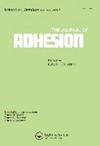Heated press welding: analysis of the parameters influencing the mechanical strength of hybrid PA66/PA12 thermoplastic and S235 steel sheet joints
IF 2.3
4区 材料科学
Q2 ENGINEERING, CHEMICAL
引用次数: 0
Abstract
ABSTRACTThis study aims to optimize and characterize hot pressed polyamide/steel hybrid joints as a potential solution for reducing energy costs in public transport through structural lightweighting. The mechanical performance of these joints is compared to traditional bonding methods, specifically investigating two types of joints: PA66/steel and PA12/steel. A design of experiments approach is employed to explore the influence of process parameters, with a particular focus on the cooling rate and heating temperature as key factors. By determining the optimal process parameters, the study emphasizes the importance of reaching the polymer pyrolysis point and achieving the fastest cooling rate to achieve optimal results. The findings reveal that these hybrid joints exhibit comparable average shear strength values to bonded joints, showcasing their potential as effective joining methods. In conclusion, future developments in hybrid polymer/metal joining processes utilizing thermal methods should prioritize rapid and uniform heating at the polymer/metal interface to initiate pyrolysis selectively at the polymer surface for bond formation. Subsequent rapid cooling is essential to cease pyrolysis and prevent polymer degradation within its volume. These insights are crucial for successful implementation of such processes in various industrial applications.KEYWORDS: Hybrid polymer/metal jointhot press weldingTAST test AcknowledgmentsThe authors are in debt to the machining operators of the Brest IUT for providing us the metal and thermoplastic specimen.Disclosure statementNo potential conflict of interest was reported by the author (s).Additional informationFundingThis action benefited from the support of Région Bretagne (ARED) and Brest Métropole Océane.热压焊接:影响PA66/PA12热塑性与S235钢板混合接头机械强度的参数分析
摘要本研究旨在优化和表征热压聚酰胺/钢混合接头,通过结构轻量化来降低公共交通的能源成本。将这些接头的力学性能与传统的粘合方法进行了比较,具体研究了两种类型的接头:PA66/钢和PA12/钢。采用实验设计的方法探讨工艺参数的影响,特别关注冷却速度和加热温度作为关键因素。通过确定最优工艺参数,强调达到聚合物热解点和达到最快冷却速度对达到最优效果的重要性。研究结果表明,这些混合接头具有与粘结接头相当的平均抗剪强度值,显示了它们作为有效连接方法的潜力。综上所述,利用热方法开发聚合物/金属杂化连接工艺的未来发展应优先考虑在聚合物/金属界面快速均匀加热,从而在聚合物表面选择性地启动热解以形成键。随后的快速冷却对于停止热解和防止聚合物在其体积内降解是必不可少的。这些见解对于在各种工业应用中成功实施此类过程至关重要。关键词:混合聚合物/金属接头压焊;tast测试;致谢致谢作者感谢布雷斯特IUT的加工操作员为我们提供了金属和热塑性试样。披露声明作者未报告潜在的利益冲突。补充信息经费本行动得到了布雷斯特·布列塔尼和布雷斯特·布列塔尼的支持。
本文章由计算机程序翻译,如有差异,请以英文原文为准。
求助全文
约1分钟内获得全文
求助全文
来源期刊

Journal of Adhesion
工程技术-材料科学:综合
CiteScore
5.30
自引率
9.10%
发文量
55
审稿时长
1 months
期刊介绍:
The Journal of Adhesion is dedicated to perpetuating understanding of the phenomenon of adhesion and its practical applications. The art of adhesion is maturing into a science that requires a broad, coordinated interdisciplinary effort to help illuminate its complex nature and numerous manifestations.
 求助内容:
求助内容: 应助结果提醒方式:
应助结果提醒方式:


